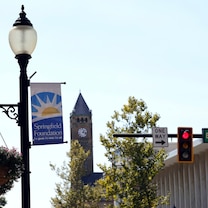Railroads and regulators must address the dangers of long trains, report says
A new report says the U.S. has seen an increase in the number of a certain kind of derailment related to the forces created when railcars push and pull against each other as freight trains have gotten longer
OMAHA, Neb. -- As freight trains have grown longer, the U.S. has seen an increase in the number of a type of derailment caused by the forces of railcars pushing and pulling against each other, the National Academies of Sciences said Tuesday in a long-awaited report that urges regulators, Congress and the industry to reexamine their risks.
Railroads should take special care in the way they assemble trains that routinely measure more than a mile or two, especially those with a mix of different types of cars, the report said, echoing a warning the Federal Railroad Administration issued last year.
“Long trains aren’t inherently dangerous. But if you don’t have adequate planning on how to put the train together, they can be,” said Peter Swan, a Penn State University professor who was one of the report's authors.
The increased use of long trains has allowed the major freight railroads — CSX, Union Pacific, BNSF, Norfolk Southern, CPKC and Canadian National — to cut costs because they can employ fewer crews and maintain fewer locomotives. The average length of trains increased by about 25% from 2008 to 2017. By 2021, when the report was commissioned, some trains had grown to nearly 14,000 feet (4,267 meters), or more than 2 1/2 miles (4 kilometers) long.
The unions representing train crews have said that longer trains are harder to handle, especially when they travel across uneven territory, because of the way cars push and pull against each other. On a train that's more than a mile (1.6 kilometers) long, one section can be going uphill while another section is going downhill. Such trains are so long that the radios rail workers use might not work from the front to the back of them.
“Anybody and everybody that’s in rail safety knows that this is a problem. It cannot be overstated," said Jared Cassity, the top safety expert at the SMART-TD union that represents conductors. "Long trains absolutely are a risk to the public and a risk to the workers and anybody with common sense can see that."
Mark Wallace with the Brotherhood of Locomotive Engineers and Trainmen said Tuesday's report reinforces what engineers have long known: “Long trains have a greater risk of derailing, have communications issues, and pose a threat to the public due to blocked crossings, among other issues.” The union urged Congress and regulators to act quickly.
The railroads say they work to ensure their trains are safe at any length. The president and CEO of the Association of American Railroads trade group, Ian Jefferies, said many railroads use software that helps them model train forces before railcars are hooked together.
“As operations continue to evolve, railroads are pulling on three key levers — technology, training and infrastructure — to further enhance safety and reliability,” Jefferies said.
But Cassity said countless derailments over the years have shown that software and the cruise control systems that help engineers operate a train are imperfect.
The number of derailments in the U.S. has held steady at more than 1,000 a year, or more than three a day, even as rail traffic decreased. Railroads say two-thirds of those are minor. Derailments have gotten increased attention since a disastrous one in East Palestine, Ohio, in February 2023 in which hazardous chemicals leaked and burned for days. That Norfolk Southern train had more than 149 cars and was 9,300 -feet-long. (1.76 miles long) But the National Transportation Safety Board determined that derailment was caused by an overheating bearing that wasn't caught in time by trackside sensors — not its length.
The biggest concern with long trains is related to derailments caused by the forces that can tear a train apart as it crosses the countryside. Tuesday's report said Congress should make sure the FRA has the power to address the dangers of those trains, and that agency should require railroads to plan carefully on how they handle them.
Railroads can make long trains easier to control by including locomotives in the middle and back of them to help pull and stop them, which is a common tactic.
The report said it's also important for railroads to take great care in where they place heavy tank cars, empty cars and specialized cars like automotive carriers that are equipped with shock absorbers.
Union Pacific said mainline derailments are down on its network over the past five years. The railroad said “technology plays a pivotal role in helping reduce variability and risk, and each year we invest billions back into our network to maintain infrastructure.”
Most of the other major freight railroads didn't immediately respond to the report.
A Federal Railroad Administration spokesperson said it has urged railroads to ensure they train their employees adequately to handle longer trains and take other steps to keep them safe. The agency is also trying to gather additional data about long trains to assess their risks.
In addition to the derailment concerns, long trains can block crossings for extended periods, sometimes cutting off ambulance and police access to entire sections of their communities. They also cause delays for Amtrak passenger trains that get stuck behind monster freight trains that can't fit within side tracks that are supposed to allow trains to pass each other in such situations.
The report said Congress should give federal regulators the power to penalize railroads for causing such problems.




